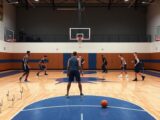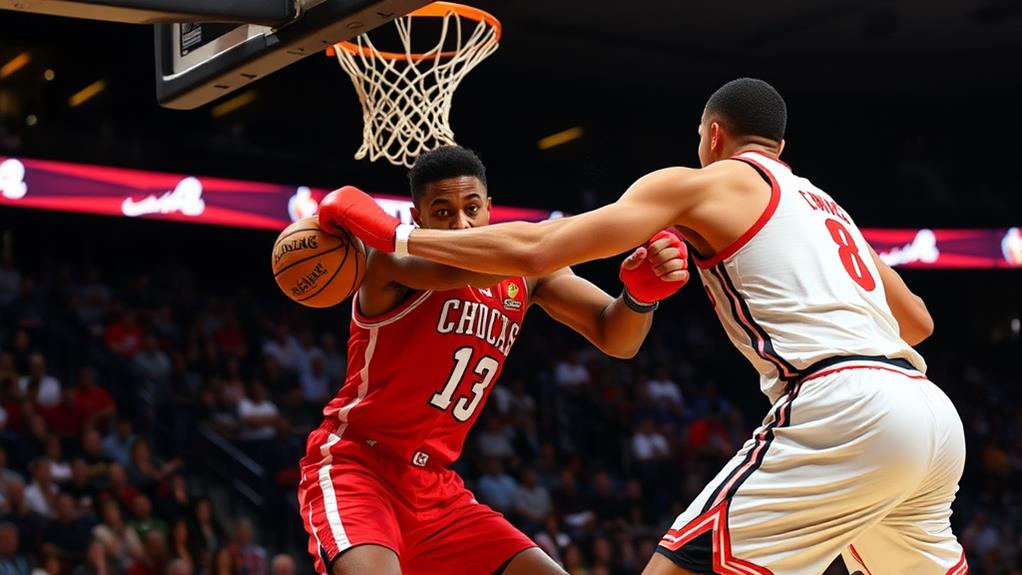
How to Master Boxing Out for Rebounding in Basketball
September 18, 2024To master boxing out for rebounding in basketball, you need to focus on body positioning, timing, and communication. Start by establishing a stable base with your feet shoulder-width apart and your knees bent to maintain balance. Anticipate the shot by watching the shooter's body language, allowing you to position yourself effectively. Use your arms to create a barrier between you and your opponent. Always communicate with your teammates by alerting them when a shot is taken. By honing these skills through targeted drills, you'll improve your rebounding game greatly. There's plenty more to explore that can sharpen your techniques.
Understanding Boxing Out
Boxing out is an essential skill in basketball, as it positions you between your opponent and the basket to secure rebounds. Understanding this technique is critical if you want to elevate your game to the next level.
To box out effectively, you need to establish a stable base. Bend your knees and keep a low center of gravity, which helps resist being pushed away from the basket. Modern defensive strategies emphasize the importance of physicality in maintaining position, which aligns with the need for effective boxing out in today's game, especially with the evolution of defensive strategies.
Extend your arms to create space between you and your opponent while keeping an eye on the ball. Timing is everything, so anticipate when the shot will go up to execute your box out effectively. Communication with your teammates is essential; yelling "SHOT!" alerts everyone to prepare for a rebound and fosters better team awareness.
As soon as the shot is taken, establish physical contact with your opponent. This keeps you aware of their position and prevents them from slipping in for a rebound easily.
Key Boxing Out Techniques
To effectively box out, you need to focus on your body positioning and timing.
Position your body between your opponent and the basket while anticipating the shot's trajectory to gain an edge.
Body Positioning Strategies
Effective body positioning is essential for mastering the art of boxing out in basketball. Start by positioning your body between your opponent and the basket, ensuring your back faces the hoop. This effectively blocks their path to the rebound.
Focus on your body stance; create a stable base by bending your knees and spreading your feet shoulder-width apart. This enhances your balance and strength against any push from your opponent.
Next, pay attention to your foot placement. Keep your feet firmly planted while maintaining a low center of gravity by staying crouched. This not only allows for quicker reactions but also gives you better leverage as you prepare to secure the rebound.
Don't forget about arm extension. Extend your arms outward to maintain space and control, making it harder for your opponent to reach around you. By keeping your arms out, you create a barrier that protects your space and increases your chances of grabbing the ball.
With these body positioning strategies in mind, you're well on your way to becoming an effective rebounder on the court.
Timing and Anticipation Techniques
Mastering the timing and anticipation techniques in boxing out can greatly enhance your rebounding skills. Start by honing your shot recognition; watch the shooter's body language closely to anticipate when they'll release the ball. This allows you to establish your position before the shot goes up, giving you an edge in securing the rebound.
Effective anticipation means recognizing the angle of the shot. By doing this, you can make accurate rebound predictions about where the ball will land. Position yourself accordingly to maximize your chances of grabbing that board.
Remember to maintain a low center of gravity; this helps with balance and stability, allowing you to react quickly when the ball is in the air.
Practice timing your box outs with the rebounder's jump. You want to make contact with your opponent just as the shot is taken, ensuring you control the space around you.
Regularly incorporate drills that simulate game scenarios to improve your anticipation skills. This will translate into better performance in actual games, giving you a significant advantage on the boards.
Rebounding Basics
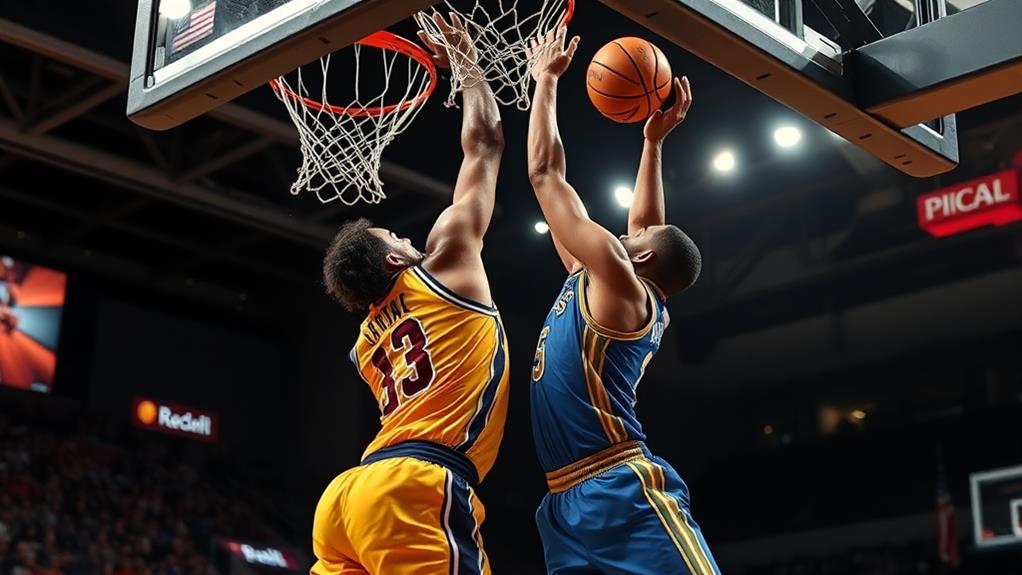
When it comes to rebounding basics, you need to understand key techniques that can make all the difference.
Knowing the types of rebounds you'll encounter and the importance of positioning will set you up for success on the court.
Effective rebounding also involves leveraging data-driven strategies to optimize your positioning and timing.
Master these elements, and you'll greatly improve your ability to secure the ball after a missed shot.
Key Rebounding Techniques
Rebounding success hinges on your ability to position yourself strategically in the paint. To maximize your chances of securing the ball, you need to understand some key rebounding techniques. Here are three essential tips:
- Establish Your Position: Always position your body between the opponent and the basket. This creates a physical barrier, making it more difficult for them to reach the rebound before you do.
- Use Your Legs and Arms: Build a strong and stable base by utilizing your legs. Keep your arms extended to maintain space and control against your opponent. This not only helps you secure the rebound but also integrates rebounding psychology by confusing your adversary.
- Anticipate and React: Watch the shooter's body language to anticipate the shot, allowing you to time your box out accurately. Maintain proper footwork and a low center of gravity for balance and explosiveness when jumping.
By mastering advanced footwork, you enhance your ability to react quickly and effectively.
Incorporating these techniques into your game will improve your rebounds and strengthen team dynamics, ultimately leading to more successful plays.
Types of Rebounds
In basketball, understanding the different types of rebounds is essential for maximizing your team's performance on the court. You'll encounter offensive rebounds, defensive rebounds, and long rebounds, each requiring unique strategies.
Offensive rebounds occur when you secure missed shots from your teammates. These give your team extra scoring opportunities and can greatly extend possessions. You'll need to be agile and avoid getting blocked out by opponents to capitalize on these chances.
Defensive rebounds, on the other hand, happen after the opposing team misses a shot. Gaining these is vital to prevent second-chance points and allows your team to shift to offense effectively. Here, establishing your position against opponents is key.
Long rebounds are trickier, as they bounce farther from the basket. To excel at these, you need to anticipate where the ball will land and position yourself accordingly.
Quick reflexes also come into play when executing tip-ins, where you score on missed shots right after they occur.
Importance of Positioning
Positioning plays a pivotal role in successfully boxing out your opponents and securing rebounds. When you understand how to control the space around you, you maximize your chances of grabbing that ball. Proper positioning not only involves your stance but also your awareness of the game.
Here are three key points to keep in mind:
- Spacing Strategies: Keep a low center of gravity with bent knees and wide feet. This position enhances your balance and makes it harder for opponents to push you away from the basket.
- Rebounding Angles: Anticipate the ball's trajectory after a missed shot. Position yourself at the right angle to react quickly, allowing you to secure the rebound before your opponents can react.
- Opponent Awareness: Always assess your positioning in relation to both the ball and your assigned opponent. Use your extended arms to create physical barriers, reinforcing your control over the rebounding area.
Types of Rebounds
When it comes to securing the ball after a missed shot, understanding the different types of rebounds is essential for any player. The evolution of sports like soccer illustrates the importance of skill development and teamwork, which are critical in basketball as well, especially when securing rebounds the origins of soccer.
Offensive rebounds occur when you grab a missed shot taken by a teammate, giving your team a chance for a second scoring opportunity. These are essential for maintaining pressure on the defense and can lead to easy points.
On the other hand, defensive rebounds are gained after an opponent's missed shot. This type of rebound is fundamental for ending the opponent's possession and shifting to your offense. Long rebounds, which bounce far from the basket, require you to adjust your positioning and timing to secure the ball effectively.
Additionally, tip-in strategies come into play when you're positioned near the basket. This involves quickly tapping or scoring off a missed shot, showcasing your anticipation and quick reflexes.
Each type of rebound demands effective boxing out techniques, as you'll need to modify your approach based on whether you're pursuing offensive or defensive rebounds. By mastering these different types, you'll enhance your overall rebounding skills and contribute considerably to your team's success.
Effective Drills for Rebounding
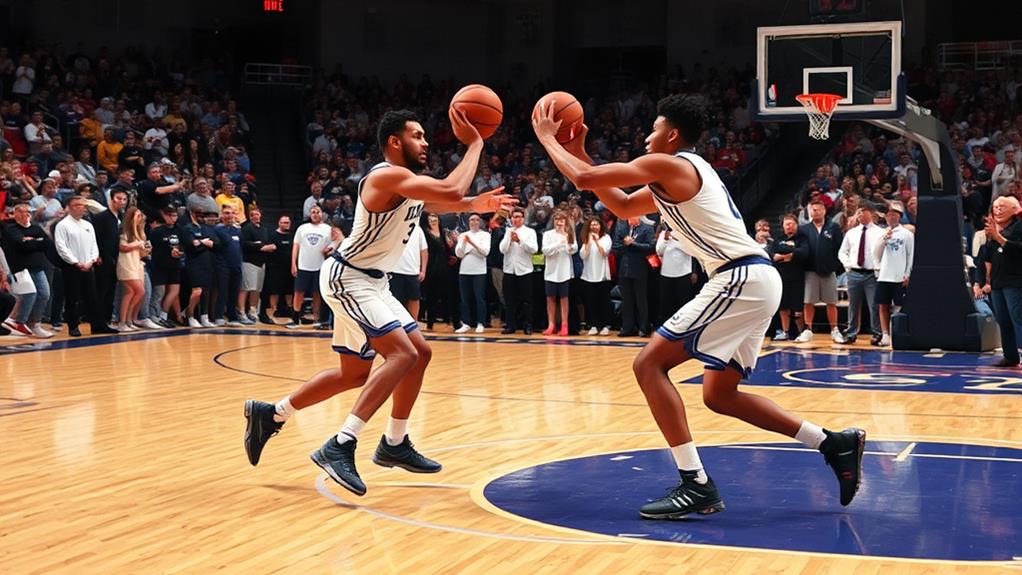
Mastering rebounding in basketball requires focused practice, and effective drills can make all the difference.
To enhance your rebounding skills, incorporate a variety of drill variations that emphasize boxing out and physicality. Utilizing a strategy similar to the 4-4-2 Classic Formation in soccer, where balance and positioning are key, can greatly improve your approach to rebounding.
Here are three drills you can implement:
- Box-Out Drills: Pair up with a teammate and practice positioning against each other. This simulates game situations, helping you refine your ability to secure rebounds under pressure.
- Jumping Drills: Work on increasing your vertical leap through specific jumping exercises. Being able to reach higher is essential for effective rebounds, so make these drills a regular part of your routine.
- One-on-One Rebounding Drills: Engage in competitive practices where you and a partner battle for the ball. This not only builds strength but also enhances your rebound strategies by forcing you to adapt to an opponent's movements.
Importance of Communication
Communication is the backbone of effective rebounding in basketball. When you yell "SHOT!", you alert your teammates, enhancing their game awareness and readiness to chase down a potential rebound. This verbal cue is essential, especially in high-pressure situations, as it promotes a collective understanding of each player's responsibilities and reduces confusion on the court.
Just as in soccer, where a strong team dynamic can lead to collective success, fostering communication can greatly elevate your team's rebounding performance consistent dedication to teamwork.
Effective communication fosters team synergy, ensuring that everyone is on the same page. By vocalizing during plays, you help your teammates identify and track their nearest opponents, which leads to better defensive accountability. When players actively communicate, they're more likely to engage in the rebounding process rather than waiting for the ball to come to them.
Establishing this habit of proactive communication can greatly enhance your team's overall rebounding efficiency. Players react quicker to rebound opportunities, allowing for more successful box-outs and securing possession.
Strategies for Success
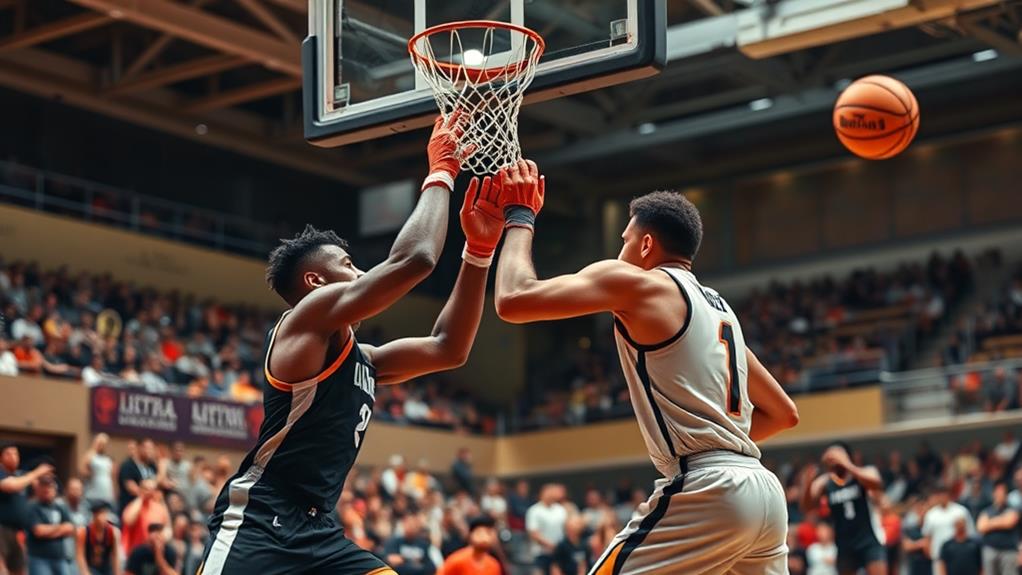
To effectively box out your opponent and secure rebounds, it's essential to implement specific strategies that enhance your positioning and timing. Mastering these techniques won't only improve your defensive strategies but also increase your chances of grabbing offensive rebounds.
Additionally, incorporating cardio workouts into your training regimen can enhance your overall athleticism, making it easier to maintain your position during intense gameplay.
- Positioning: Always position your body between your opponent and the basket. Use your legs to create a stable base while keeping your arms extended to control space. This stance is imperative for maintaining balance and making it harder for opponents to push you away.
- Anticipation: Anticipate the shot's trajectory. By predicting where the ball will land, you can time your box out accurately, which boosts your chances of securing the rebound.
- Communication: Shout "SHOT!" to alert your teammates. This simple call guarantees everyone understands their boxing out responsibilities, fostering teamwork and mental toughness as you work together for the rebound.
Conclusion
Now that you've learned the ins and outs of boxing out and rebounding, it's time to put those skills to the test. Picture the game on the line, the clock ticking down, and you're ready to secure that vital rebound. Will you rise to the challenge and dominate the boards? Embrace these techniques, stay focused, and remember: every rebound counts. Get out there and show everyone what you've got! The court is waiting for your moment to shine.

